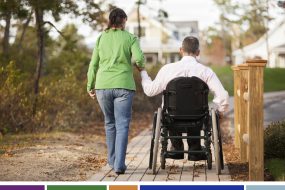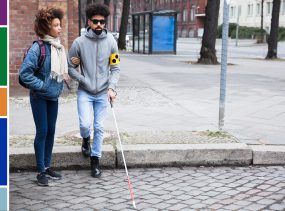Sexual Violence and Intimate Partner Violence Among People with Disabilities

Understanding Violence Against People with Disabilities
Disability affects more than 1 in 4 women and 1 in 5 men in the United States and has been associated with a greater risk of experiencing violence compared to people without a disability. In the National Intimate Partner and Sexual Violence Survey (NISVS), the term “disability” includes activity limitations an adult may have due to physical, mental, or emotional problems and health problems that require the use of special equipment such as a cane, wheelchair, special bed, or special telephone. Findings from NISVS show that women and men with a disability are at increased risk for experiencing sexual violence (SV) and intimate partner violence (IPV).
Scale and Scope of the Problem
People with disabilities are particularly vulnerable to SV and IPV. The information below is based on NISVS data that captured experiences occurring in the past 12 months before taking the survey. These figures likely underestimate the true burden of SV and IPV victimization and exclude adults living in institutions such as prisons, group homes, and nursing homes.
Sexual Violence

Women with a disability are at greater risk of experiencing rape than women without a disability. An estimated 2 in 5 (39%) female victims of rape had a disability at the time of the rape.
Men with a disability are at greater risk for experiencing SV other than rape (e.g., being made to penetrate, sexual coercion, unwanted sexual contact, and noncontact unwanted sexual experiences) than men without a disability. Nearly 1 in 4 (24%) male victims who experienced SV other than rape had a disability at the time of the victimization.
For both women and men, having a disability was associated with an increased risk of sexual coercion (pressured sex without physical force) and noncontact unwanted sexual experiences (e.g., harassed in a public place, made to participate in or view sexually explicit material).
Intimate Partner Violence
Women with a disability are more likely than women without a disability to report experiencing rape, SV other than rape, physical violence, stalking, psychological aggression, and control of reproductive or sexual health by an intimate partner. Men with a disability are more likely than men without a disability to report experiencing stalking and psychological aggression by an intimate partner.
Preventing Violence Against People with Disabilities
By understanding that disabled persons are at greater risk of experiencing SV and IPV victimization than persons without a disability, we can take action in our communities to stop the violence before it starts. The strategies and approaches in the SV [3 MB, 46 Pages] and IPV [5 MB, 62 Pages] Resources for Action, formerly known as, “technical packages,” may help reduce violence among those with a disability.
- Rape, Abuse and Incest National Network’s (RAINN) National Sexual Assault Hotline
- Call 800.656.HOPE (4673) to be connected with a trained staff member from a sexual assault service provider in your area.
- Rape, Abuse and Incest National Network’s (RAINN) National Sexual Assault Online Hotline
- Visit online.rainn.org to chat one-on-one with a trained RAINN support specialist, any time 24/7.
- National Sexual Violence Resource Center
- PreventConnect
- Violence Against Women
- Call the OWH HELPLINE: 1-800-994-9662
- Breiding, M. J., & Armour, B. S. (2015). The Association between Disability and Intimate Partner Violence in the United States. Annals of Epidemiology, 25(6), 455-457.
- Basile, K. C., Breiding, M. J., & Smith, S. G. (2016). Disability and Risk of Recent Sexual Violence in the United States. American Journal of Public Health, 106(5), 928-933.
- Basile, K.C., DeGue, S., Jones, K., Freire, K., Dills, J., Smith, S.G., Raiford, J.L. (2016). Sexual Violence Prevention Resource for Action: A Compilation of the Best Available Evidence. Atlanta, GA: National Center for Injury Prevention and Control, Centers for Disease Control and Prevention. Note: The title of this document was changed in July 2023 to align with other Prevention Resources being developed by CDC’s Injury Center. The document was previously cited as “Preventing Intimate Partner Violence Across the Lifespan: A Technical Package of Programs, Policies, and Practices.”
- Niolon, P. H., Kearns, M., Dills, J., Rambo, K., Irving, S., Armstead, T., & Gilbert, L. (2017). Intimate Partner Violence Prevention Resource for Action: A Compilation of the Best Available Evidence. Atlanta, GA: National Center for Injury Prevention and Control, Centers for Disease Control and Prevention. Note: The title of this document was changed in July 2023 to align with other Prevention Resources being developed by CDC’s Injury Center. The document was previously cited as “Preventing Intimate Partner Violence Across the Lifespan: A Technical Package of Programs, Policies, and Practices.”